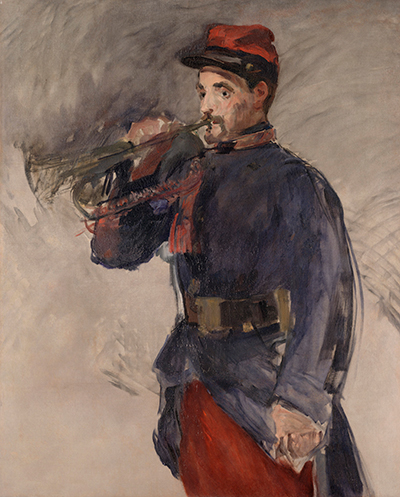Manet's The Bugler (Le Clairon) is an oil on canvas painting completed in 1882 and exhibited in 1883.
It was displayed at the Paris Salon alongside The Amazon (L'Amazone) and depicts a portrait of a bugler in military uniform. This is a monumental painting in Manet's oeuvre because it was painted in the last months of Manet's life. When working on touch-ups to The Amazon following its showing, Manet's friend and fellow artist Pierre Ernest Prins visited Manet and found him floundering "as if blind" in his studio. This progressed to the point of wandering toward The Amazon and slashing it with a palette knife. Although The Bugler was not physically destroyed by Manet, he struggled with the painting in his final year. Manet died weeks later following the amputation of his leg from gangrene and after suffering from syphilis.
As one of his last paintings, The Bugler underscores Manet's latter style; a blend and bridge between Realism and Impressionism. As with many of Manet's works, he attempts to encapsulate the intangible in this work by paying attention to the aural performance of the bugler and translating his performance into a visceral visual image. Édouard Manet (1832 - 1883) was a renowned French painter, considered by many to be that father of modern art. Manet's career oversaw the transition between Realism and Impressionism in European painting.
Although Manet had strained critical success in the conservative Salon culture of his time, he—along with Oscar-Claude Monet—appealed to a broad range of young and avant-garde artists in France as an early influence on Impressionism. Manet himself came from rich beginnings and experienced a bourgeois upbringing that expected him to go into a respected career like law. Instead, Manet took an early interest in art which persisted into his teens. Manet then studied under the esteemed academic painter and educator Thomas Couture and was greatly influenced by both Gustave Courbet and the Old Masters.
After opening his studio in 1956 at the age of twenty-four, Manet soon began breaking the conventions he had learnt, adopting a philosophy toward his subject and style that was influenced by contemporary literature. Most prominent among these influences was the work of Charles Baudelaire. Baudelaire had called for artists across mediums to get to the root of modern life, to represent what they see and create an accurate new art for their time. Manet himself took on many controversial subjects, depicting down-and-outs, courtesans and street life with an uncompromising and direct eye.




